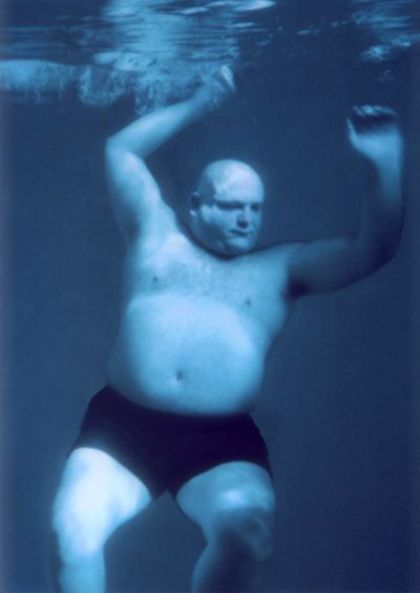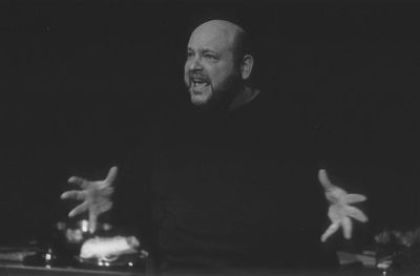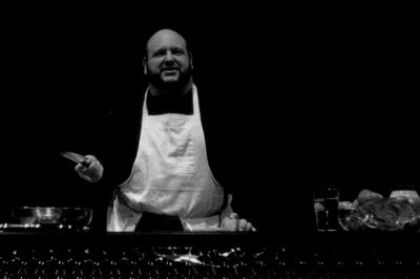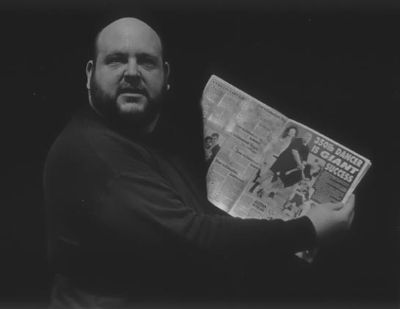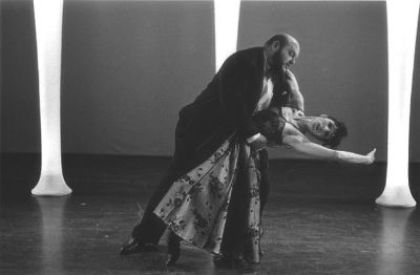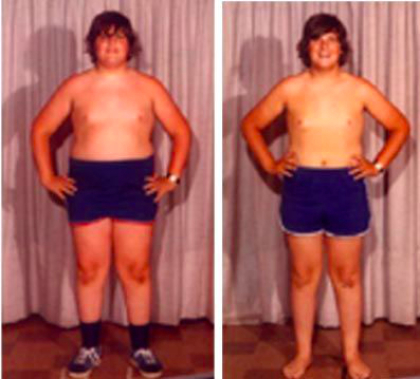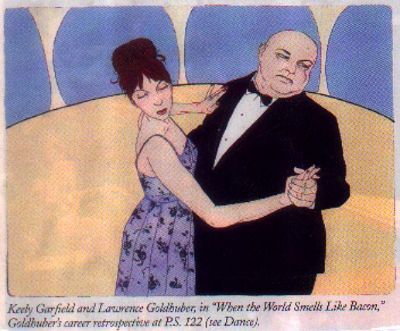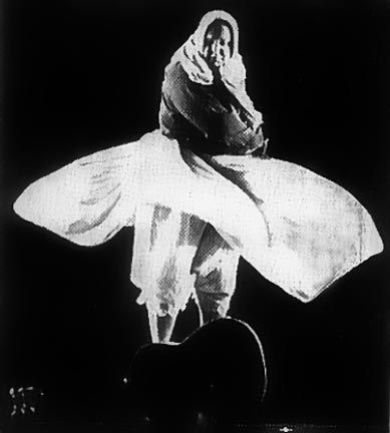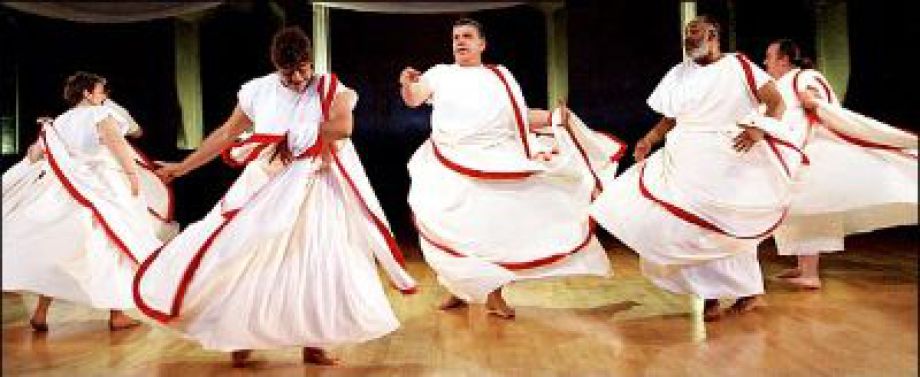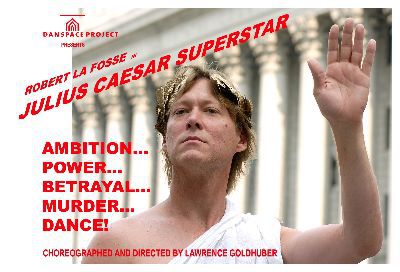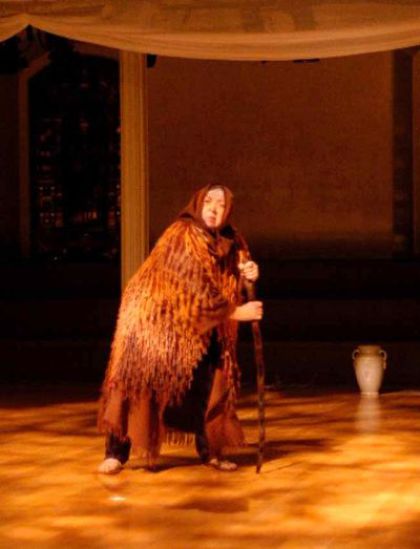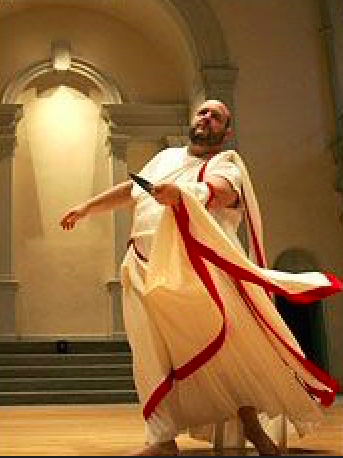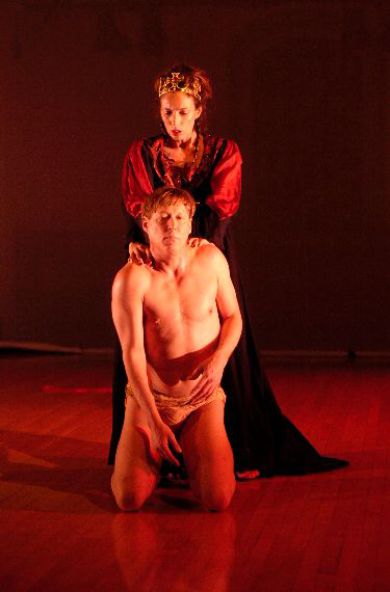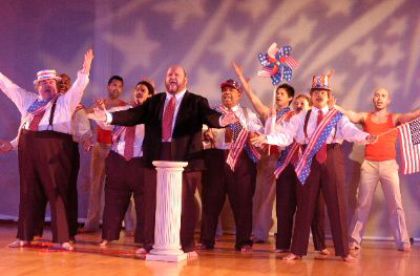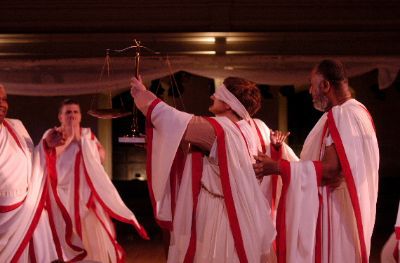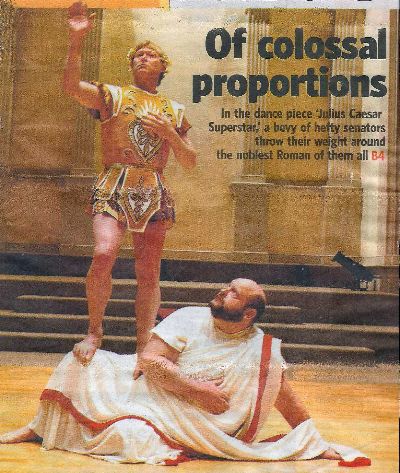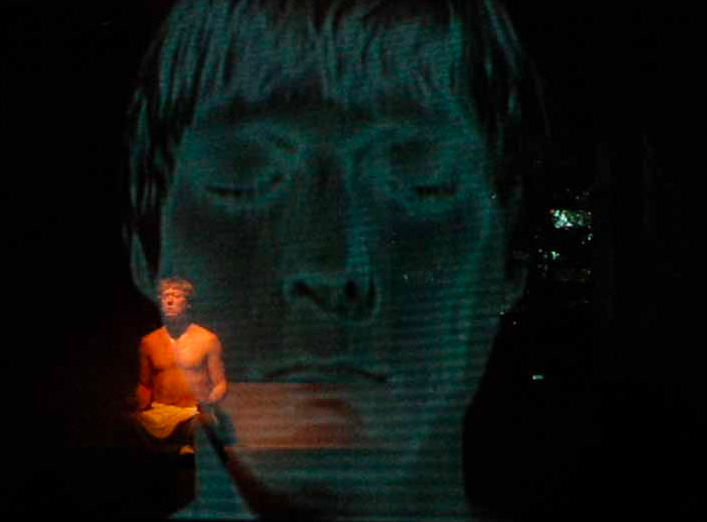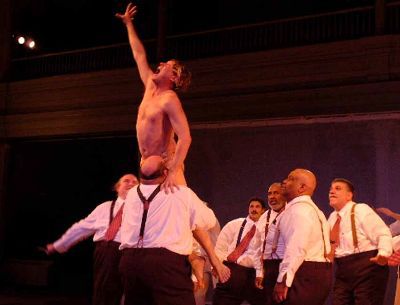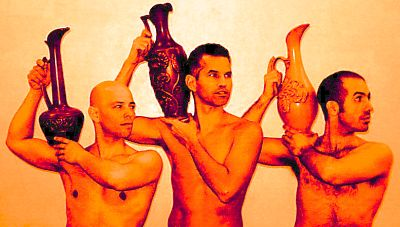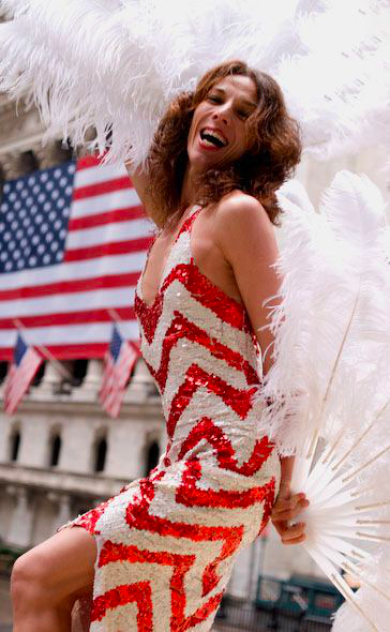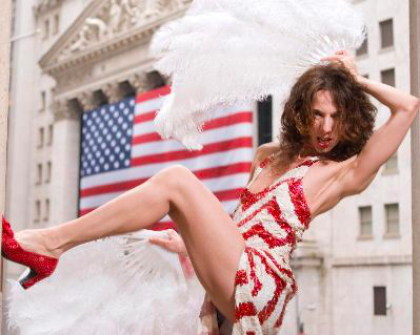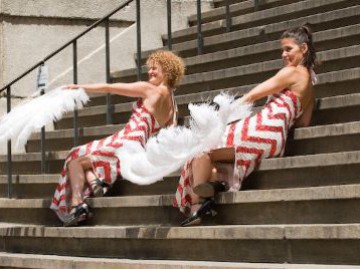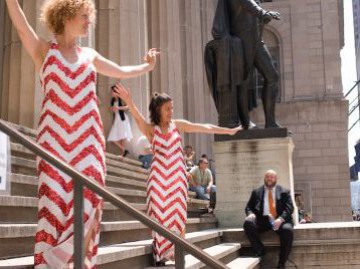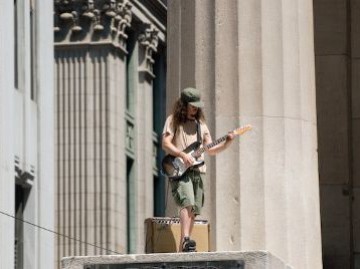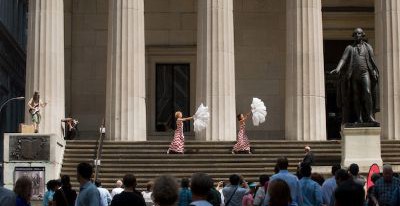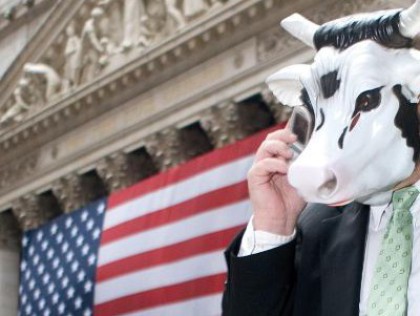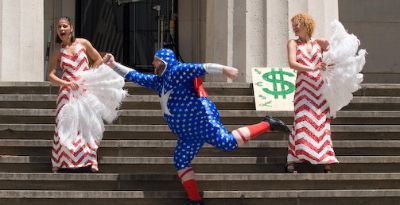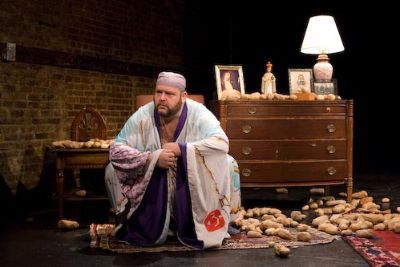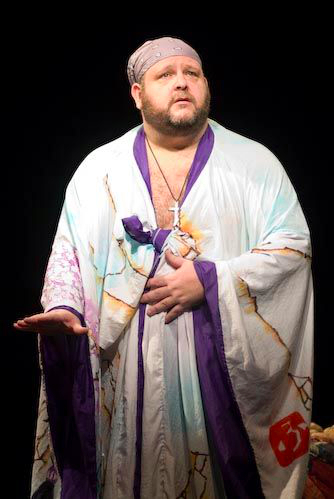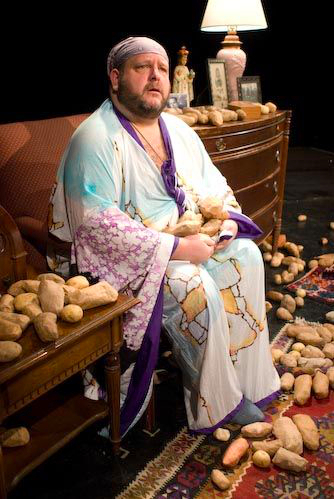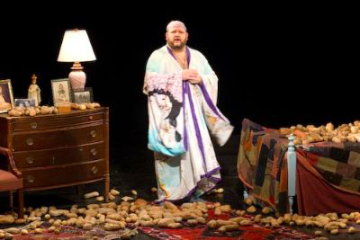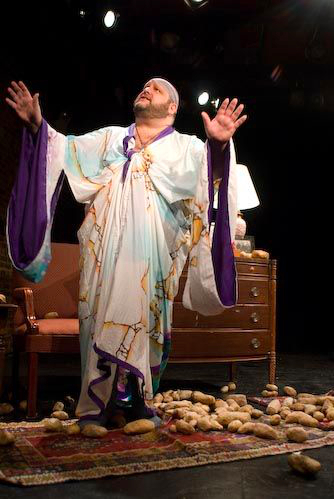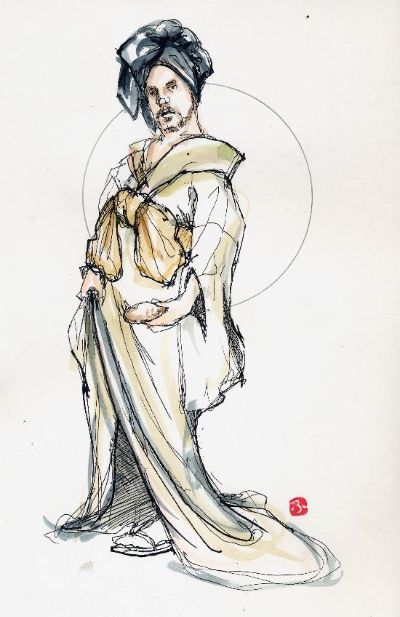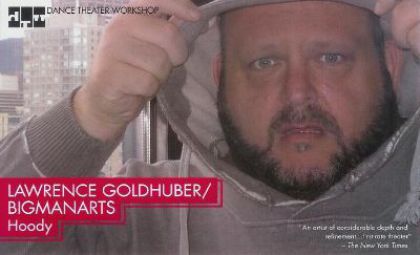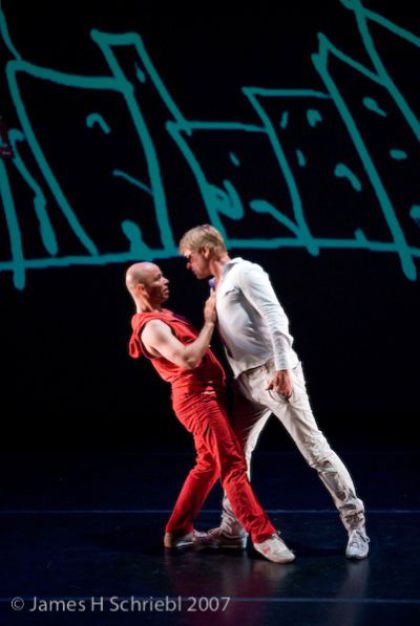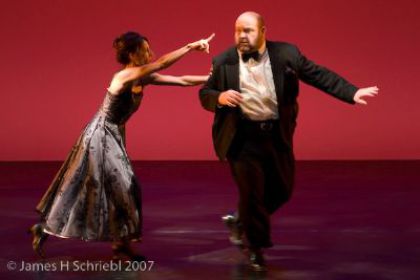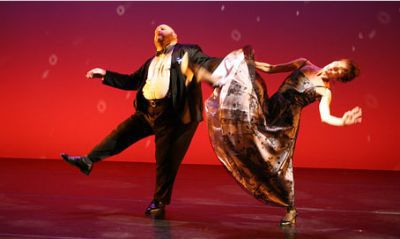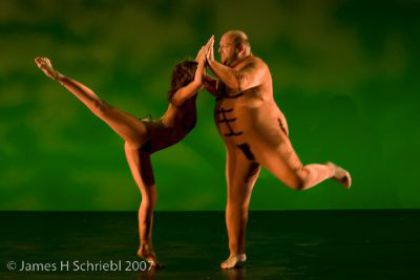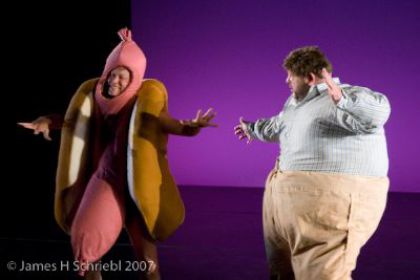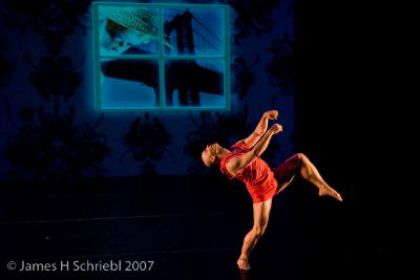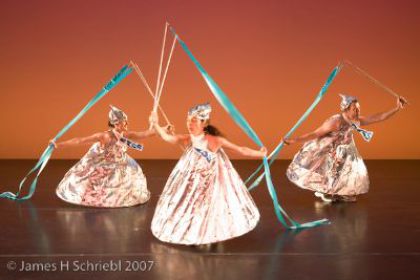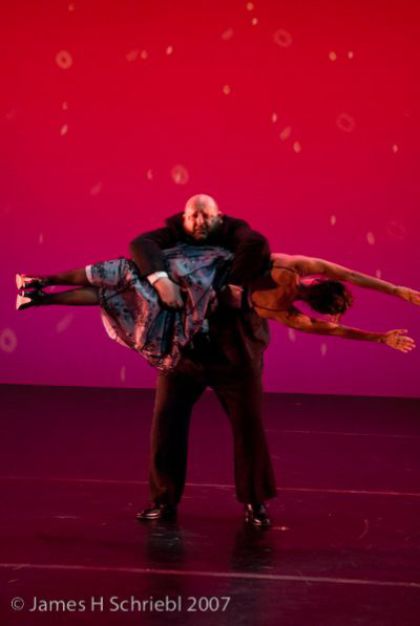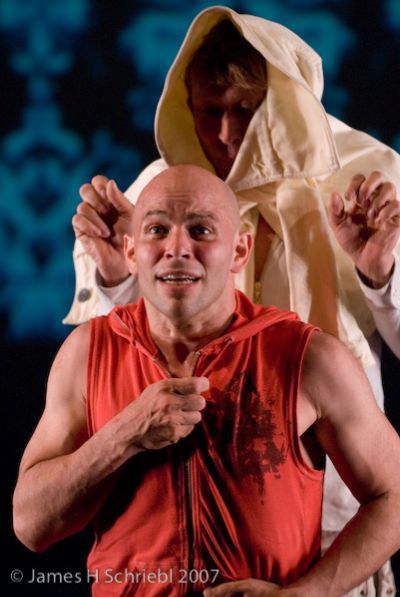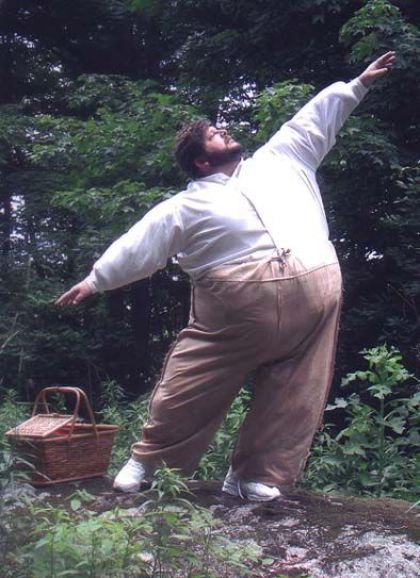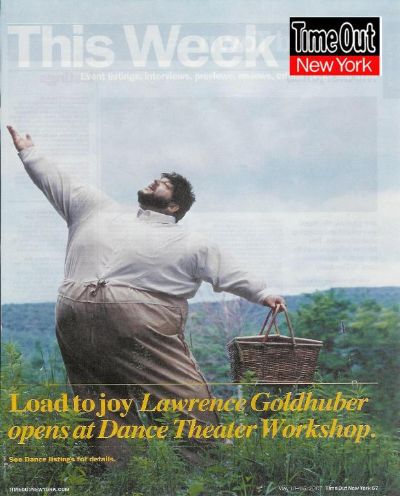CONTACT: GOLDHUBER@GOLDHUBER.COM
============================================
WHEN THE WORLD SMELLS LIKE BACON
AND OTHER WORKS
"first-rate theater with a surprising edge of poignancy" The New York Times
PERFORMANCE SPACE 122 AND BIGMANARTS
PRESENT
WHEN THE WORLD SMELLS LIKE BACON and other works
PROGRAM
WHEN THE WORLD SMELLS LIKE BACON (2001)
Written and performed by Lawrence Goldhuber
Lighting Design by Robert Wierzel
Commissioned by Performance Space 122 with funds from The Jerome Foundation.
FILM: HEAD DUET (2000)
Directed by Gretchen Bender
Choreographed by Goldhuber & Latsky
Music by Joe Jackson
Commisioned by The Joyce Theater Altogether Different Fund for New Works
and produced with the generous support of
John and Sage Cowles, Jerome Goldhuber, Pierre Apraxine, and Cindy Sherman.
SOY (I AM) (1998)
Choreographed by Goldhuber & Latsky
Costume by Liz Prince
Lighting Design by Robert Wierzel
Music sung by Lola Beltran
FILM: COMMERCIAL REEL
KING KONG (excerpt from LOVE DEFINED) (1992)
Choreographed by Bill T. Jones
Lighting Design by Robert Wierzel
Music by Daniel Johnston
This work was originally commissioned by the Lyon Opera Ballet.
FILM: THE FIGHT (1992)
Directed by Nuria Olive-Belles
featuring Javier DeFrutos and Ramon Baeza
DANCES WITH WOLVES (2001)
Performed by Keely Garfield and Lawrence Goldhuber
Choreographed by Lawrence Goldhuber with Keely Garfield
Music by Esquivel, Astaire, Khacaturian, Aretha, Elvis.
Set Design by Gisela Stromeyer
Lighting Design by Robert Wierzel
Commissioned by Performance Space 122 with funds from The Jerome Foundation. It has also been made possible by a generous space grant through the 92nd Street Y-Harkness Dance Program. (2000)
CLICK PHOTO TO WATCH DANCES WITH WOLVES
CARICATURE IN THE NEW YORKER BY LARA TOMLIN
NEW YORK TIMES DANCE REVIEW
WHEN THE WORLD SMELLS LIKE BACON: A TASTY B.L.T. FOR A MEDITATOR WRIT LARGE

by Jennifer Dunning
Lawrence Goldhuber called his evening of dance "When the World Smells Like Bacon." He also made and began to eat a bacon, lettuce and tomato sandwich on the stage in the
title piece, a meditation on families, Judaism and being fat, in a program presented on Sunday night at P.S. 122.
Mr. Goldhuber, a former Bill T. Jones dancer famous for his 350-pound weight, turns such everyday topics into charmingly unassuming, first-rate theater with a surprising edge of poignancy.
The centerpiece of the program was the new "Dances With Wolves," created and performed with Keely Garfield. The two make an enjoyably sly pair of combative, nutty lovers as they glide about the floor
to old and new popular favorites. It is fun to see them doing a "Fred and Ginger" every now and then in a score that includes Astaire singing "Let's Face the Music and Dance."
But even better is their comic timing and Mr. Goldhuber's small, oddly telling gestures, as when he appears to write disconsolately across the bottom of Ms. Garfield's sequined gown.
Gisela Stromeyer's simple set creates an elegant ballroom, with the bright colors of Robert Wierzel's lighting bouncing off curved fabric pillars.
Mr. Goldhuber is good at evoking large worlds in small solos. King Kong and the sadness of unlikely yearning come touchingly alive in "Love Defined." Mr. Goldhuber's guitar-playing old woman in "Soy
(I Am)" suggests a range of emotions and also, cleverly, of early modern-dance images.
Mr. Goldhuber plays the bemused referee of a sensual boxing match in Nuria Olive-Belles's stylish film, "The Fight," and makes nuzzling love to Heidi Latsky with his head in Gretchen Bender's
stylized "Head Duet," also a film. February 9, 2001
CLICK PIC BELOW TO SEE NURIA OLIVE'BELLES' THE FIGHT
VILLAGE VOICE DANCE REVIEW
by Deborah Jowitt
You can't exactly say that Lawrence Goldhuber is coming out as a fat dancer. He did that without explanation years ago in the company of Bill T. Jones and Arnie Zane.
And we loved him for it. But in When the World Smells Like Bacon, part of his P.S. 122 program earlier this month, Goldhuber good-humoredly explained his heredity (holding up pictures that showed the
achievement and disappointing aftermath of his teen years in weight reduction camps) and humiliating performing experiences, while tantalizing us with the smell of bacon he's frying up for a BLT.
Just so we know what he feels like every day. He also runs us through his career as a successful heavyweight in a collage of '80s TV commercials edited by David Brooks. He's a knockout as the Lotus
salesman leading an entire office staff in a jubilant, it's-changed-our-lives dance.
Goldhuber uses his size (and gender) to more poignant effect in the 1998 Soy (I am) choreographed with erstwhile partner Heidi Latsky. In this he's an old woman in a head shawl, holding a guitar and
undulating massive hips, while Lola Beltran's taped voice sings mournfully of solitude. Scrubbing the floor with her skirt, reverently covering her guitar with her scarf, this woman enters your mind
and won't get out. Goldhuber reminds us how wonderfully Jones featured his bulk in a sad King Kong solo from Jones's 1992 Love Defined.
Some pieces have nothing to do with Goldhuber's physique. In Gretchen Bender's film Head Duet, he and Latsky nuzzle each other and entwine lovingly, the camera watching from very close or from above.
In the charming new Dances With Wolves, he and Keely Garfield play off one another in a sour Fred-and-Ginger routine, the pair's superb comic timing and performance subtleties a delight. Amid clever
white fabric columns by Gisela Stromeyer, they traverse the dance floor with tiny, well-behaved steps that include a little rhythmic hiccup as a sign of trouble to come. He lifts her, and both look
pleased. Next minute, they're yanking each other into huge, clumsy leaps. Refinement only temporarily masks rage and confusion. In the end, she shreds his credit card. FEBRUARY 27,
2001
==========================================
JULIUS CAESAR SUPERSTAR
Members of Lawrence Goldhuber's Bigmanarts troupe swirling their togas
in "Julius Caesar Superstar" at Danspace Project on Thursday night.
Photo: Julie Lemberger/New York Times
"...a terrific romp...a joyous, giddily epicine gathering... The New York TImes
"a highly entertaining hourlong dance piece distinguished by biting humor, stunning visual effects, and slyly crafted movement drama...super show"
Backstage
"a work that charmingly, sometimes recklessly, blends hilarity, tragedy, and camp" The Village Voice
"a great, sweeping work that comes on like a vest-pocket Broadway smash"
Dancing with Eva Yaa Asantewaa
CLICK PIC TO SEE THE SHOW
DANSPACE PROJECT and BIGMANARTS present
JULIUS CAESAR SUPERSTAR
Choreographed and Directed By Lawrence Goldhuber
Original Music By Geoff Gersh
Additional music by Handel, Vivaldi, and Vandross
Video By Janet Wong
Lighting Design By Kathy Kaufmann
Costume Designs By Liz Prince
Technical Director: Mandy Ringger
Editing Advisor: Valeria Vasilevski
Assistant to the Choreographer: Tony Wicks
Technical support: Mitchell Wagenberg / Street Vision
Starring (in alphabetical order):
Rhetta Aleong, Arthur Aviles, Sydney Boone
Eric Stephen Booth, Alberto Denis, Loren Kiyoshi Dempster
Marcelo Rueda Duran, Thom Fogarty, Keely Garfield
Lawrence Goldhuber, Robert La Fosse, Rosalynde LeBlanc
Valentin Ortolaza, Hapi Phace, Micki Saba, and Micki Wesson
JULIUS CAESAR SUPERSTAR features ballet star Robert La Fosse in the title role, surrounding him with eight 300-pound performers as the conservative senators who murder him. The show, choreographed, and directed by Lawrence Goldhuber, moves from the Roman baths through to the U.S. Senate of 1950's McCarthyism, with ambition, power, and betrayal around every corner. Original music by Geoff Gersh (of Straylight) is combined with excerpts from previous interpretations of the Caesar story to deliver a driving soundscape. The cast includes musicians, a soothsayer, muscled men performing as soldiers, slaves, and statues, as well as a surprise appearance by the evil Lady Macbeth who escorts our hero to the afterlife. Vibrant costumes are designed by frequent collaborator Liz Prince. Gregory L. Bain's sleek production design and Kathy Kaufman's brilliant lighting complete the creative team.
The creation of JCS was made possible, in part, with funds from the Danspace Project's 2004-05 Commissioning Initiative with support from The
Andrew W. Mellon Foundation
BIGMANARTS is supported by The Jerome Foundation in celebration of the Jerome Hill Centennial and in recognition of the valuable cultural contributions of artists to society.
JCS was created during a residency provided by The Joyce Theater Foundation, New York City, with major support from The Andrew W. Mellon Foundation.
The original and live music for this evening's performance was commissioned by
The American Music Center Live Music for Dance Program.
JCS has received generous funding from The Bossak/Heilbron Charitable Foundation, The Harkness Foundation for Dance, and from many individual donors.
These performances are made possible in part by the Manhattan Community Arts Fund/New York City Department of Cultural Affairs, administered by the Lower Manhattan Cultural
Council.
JCS is a sponsored project of the New York Foundation for the Arts (NYFA),
a 501(c)3, tax-exempt organization founded in 1971 to work with the arts community throughout New York State to develop and facilitate programs in all
disciplines.
These performances are dedicated to friend and colleague Gretchen Bender,
who passed away this winter. She was to have participated in the creation of this show and she is greatly missed.
Special Thanks: Laurie Uprichard, Kathy Kaufmann, Mandy Ringger, and everyone else at Danspace Project for their ease and clarity, Robert La Fosse and the entire
cast and crew for the months of work, Janet Wong's talent, Mitchell Wagenberg's generosity of spirit and equipment, Tony Wicks for filling in, everyone at The Joyce SoHo, Bruce Imber /Monkey Hill,
James Schriebl Photography, Ellen Jacobs, Heidi Latsky and Stephen Jones, Liz for the endless additions, GLB for coming through, Anna Smith at the American Music Center for the extra help, and
both Robert Byrd at The Jerome Foundation, and Linda Shelton and Martin Wechsler at The Joyce Theater Foundation for their continuous support.
An extra special thank you to all contributors: Pierre Apraxine, Connie Beckwith, Gretchen Bender, Susan Blankensop, Mark and Linda Brinkman, David and Carlene Cedoz, Paul and Sheila
Cohen, John and Sage Cowles, Lauren Cramer, Amber Denker, Geoff Gersh, Jerry Goldhuber, Stephanie Goldhuber, Ed and Susan Gitkind, Mary Gridley, Kenneth Grosjean, Carol Holding, Bruce Imber,
Joseph Jaros, Sarah East Johnson, Doris Klapper, Mary Kusian, Julie Landman, Robert Landman, Claire Leffel, Janet Lilly, Steve Mendelsohn, Eric Menkes, Ray and Fran Osinoff, Susan and Shelly Osinoff,
Annie-B Parson and Paul Lazar, William and Joan Peak, Nicolas Ramirez, Jeanette Resnick, Nat and Bunny Ritzer, Jeffrey Seller, Bea Scherer, Keven Scherer and Shari Vice, Benedicta Schwager, Sidney
Schwager, Cindy Sherman, Todd and Clare Smith, Jerry Spano and Danielle Violi, Jack Sparrow, Megan Stager, Rose Storin, Bonnie and James Summerford, Susan and Fred Tapper,
Anita Tierney, Valeria Vasilevski, Micki Wesson, Mitchell Wagenberg, Martin Wicks, and Wallie Wolfgruber. Thank you many times over.
===========================================================================================================
NEW YORK TIMES DANCE REVIEW
JULIUS CAESAR AND HIS CLOSE FRIEND LADY MACBETH
By JENNIFER DUNNING
GOLDHUBER AS BRUTUS
PHOTO: CHANG W. LEE/NEW YORK TIMES
There is nothing quite like a dancing chorus of agile 250-pound men in togas. Who would have known it, though, if not for Lawrence Goldhuber and his new "Julius Caesar Superstar," which opened on
Thursday at the Danspace Project at St. Mark's Church.
Performed by Mr. Goldhuber's Bigmanarts company, the piece depicts the murder of Caesar, followed by a duet for Caesar and Lady Macbeth, who escorts him to the netherworld. Dressed in modern-day
business suits by now, the senators return with Caesar's guards for a rousing performance of a song called "Can't You Feel the Brand-New Day?" American flags wave, and a shower of red-and-white
confetti ends the hourlong show.
If this is meant to be sociopolitical commentary, and apparently it is, the most pointed moment of wit comes as one senator (Hapi Phace) enthusiastically signs the song at the side of the group. But
"Julius Caesar Superstar" is simply a terrific romp at heart. It is also a handsome-looking show, particularly in a scene in which a video of Caesar's grimacing, smiling, revolving head is projected
on a scrim that the senators plot behind in the baths. Liz Prince's vividly stylish costumes are inspired.
Most of all, this is a joyous, giddily epicene gathering of the downtown-dance clan to which everyone is invited, from the audience to the uptown ballet star Robert La Fosse, who plays Caesar, and
the dance patron Micki Wesson, who anchors the evening with her gravitas as a soothsayer and a judge.
There are poignant moments, chiefly in a solo for the dying Caesar and in his duet with Lady Macbeth, played by a deliciously poker-faced Keely Garfield.
Thom Fogarty brings a bracing simplicity to his senator, and Arthur Aviles is enjoyably cheeky as a guard.
Published: May 14, 2005
CLICK HERE TO READ
DANCE REVIEW
DANCEVIEWTIMES : WRITERS ON DANCING
HAIL CAESAR! SORT OF...
BY SUSAN REITER
BACKSTAGE DANCE REVIEW
BY LISA JO SAGOLLA
Lawrence Goldhuber is an ingenious theatrical director. His latest production, "Julius Caesar Superstar," is a highly entertaining hourlong dance piece distinguished by biting humor, stunning visual effects, and slyly crafted movement drama.
Presented at St. Mark's Church, the work makes exquisite use of the venue's spatial idiosyncrasies to create marvelously atmospheric settings, including a steamy Roman bath (complete with sensuous nude "statues"), a frightening McCarthy-era courtroom, and a rousing Republican National Convention. Goldhuber's version of Caesar's story begins historically -- featuring a cast of eight 300-pound performers as the conservative senators who betray their leader, apparently because of his overappreciation for homoeroticism. However, Caesar's murder takes place at a trial held in the conservative climate of 1950s America, and the fat men's victory celebration is depicted as today's Republicans hailing the conservative politics of George W. Bush. In what is perhaps the funniest finale we've ever witnessed at a dance performance, Goldhuber sends his "fat cats" into a patriotic hullabaloo of a production number. They sing and dance gleefully to a sickeningly upbeat pop song as flags wave, confetti falls, and a cheesy sign-language interpreter performs to hilarious effect.
The choreographic highlight of Goldhuber's work occurs just after the killing of Caesar. Portrayed by ballet superstar Robert La Fosse, whose graceful, boyish interpretation of the role appropriately imbues the powerful character with a haunting vulnerability, Caesar is visited in the afterworld by Lady Macbeth. They dance an edgy pas de deux built of engagingly off-kilter actions suggesting betrayal, guilt, and fear.
Enhanced by Geoff Gersh's original music, Liz Prince's right-on-target costumes, and Janet Wong's penetrating video of Caesar's oversized, agonized countenance, "Julius Caesar Superstar" is indeed a super show.
DANCING WITH EVA YAA ASANTEWAA: EXCLUSIVE REVIEWS
Review No. 25
Posted: May 16, 2005
Lawrence Goldhuber/BIGMANARTS
Danspace Project
May 13, 2005
Exhilarating! Lawrence Goldhuber's new dance drama, Julius Caesar Superstar, does everything on a grand scale. Sure the piece has a cast of heavyweights playing Roman senators who, like the famously portly Goldhuber, carry considerable heft either through natural endowment or fat-suit enhancement, but that's not what I'm talking about.
By "everything" I mean choreography, musical score, video, lighting, and costumes-all contributing generously to a great, sweeping work that comes on like a vest-pocket Broadway smash, all packed into the space of an hour. The production moves swifter than you might expect and never flags-just like Goldhuber and his senatorial co-conspirators. Even its excesses seem purposeful. That's some kind of magic!
Julius Caesar Superstar takes us back in time to make a point about the present. The clownish Roman senators-among them the delightful Goldhuber, Thom Fogarty, and Rhetta Aleong (yes, a woman in drag), open the evening with lively and intricate circle dances, red-trimmed togas aswirl. Their joyous dancing spans the length of Danspace's floor and, along with Kathy Kaufmann's lighting, opens it up and enlivens it in ways I've never seen before. In fact, nearly every part of the space gets pressed into service-the arched, stained-glass windows momentarily illuminated, the balcony visited by trumpeters to herald the approach of a war hero, the sanctuary steps turning into a sybaritic, raunchy display, the risers transformed by a wide scrim into the steamy baths where towel-draped senators casually stroll, snooze, and plot revolution.
Julius Caesar Superstar, played by that good-looking ballet superstar Robert LaFosse (ABT, New York City Ballet, Tharp), is attended by bare-legged prancing soldiers. (Or should that be, soldiers with invisible prancing horses?) These are played, in snappy high spirits, by Arthur Aviles, Alberto Denis, Marcelo Rueda Duran, and Valentin Ortolaza, Jr. Let's support our troops and praise these wonderful guys. Not only are they brilliant as Roman guards but they take other roles, too. As boy servants, for instance, they have their own ritualistic circle dance (with wine vessels) featuring comely, synchronized moves and delicate crossing steps. Goldhuber's work here is particularly gorgeous and witty. Later, the four will also play classical sculptures in the bath-how do they hold those contorted poses so long?-as well as Abu Ghraib-type guards and political convention cheerleaders.
And then there's Micki Wesson, the real heavyweight of the show-moral heavyweight, that is. As the mysterious soothsayer, she points her crooked staff, silently speaking truth to power. She's got Caesar in her sights. He may cackle in scorn, but he's a goner.
The senators, realizing that Caesar is a drunken, power-mad libertine, begin to plot against him, distancing themselves from him as he lolls about in the steam of the bath. For some dazzling moments, the scrim displays a black-and-white video of LaFosse's face with a paranoid or death-mask expression. The image is huge. Its cold glow spills from the scrim onto the wooden floor, making the entire scene vibrate with light.
Fast forward to America of the McCarthy-ite '50s. Caesar, stripped down to a loincloth, gets roughed up by a pack of senators (wardrobe updated to slacks, shirts, suspenders, and ties). He's stabbed numerous times. Goldhuber kisses him square on the mouth-hard and long-before driving home the fatal wound. Caesar survives long enough to play out a rather involved death scene culminating in a beauty of a duet with Keely Garfield as a severe but loving Lady Macbeth. What? You don't think that Lady Macbeth might greet Julius Caesar at Death's door and help him cross over? Listen, they're terrific together!
In the twinkling of an eye, we're at a red-white-and-blue political convention complete with sparkling confetti. Which party? Maybe it doesn't matter. But the big number-"Can't You Feel the Brand-New Day?"-intensely sung by conventioneers who seem just short of rage, is entirely too reminiscent of Bush's oft-repeated "Freedom's on the march in Iraq!"
Goldhuber now wears Caesar's wreath. Meet the new boss. Same as the old boss.
©Eva Yaa Asantewaa, http://home.mindspring.com/~magickal1/
========================================== WHOSE BROAD STRIPES
PRESENTED BY LMCC SITELINES 07
FEDERAL HALL NATIONAL MEMORIAL
WALL STREET 2007
FEATURING AMBER MARTIN, PATRICIA HOFFBAUER with GEOFF GERSH ON GUITAR
ALL PHOTOS: JAMES SCHRIEBL PHOTOGRAPHY
TIME OUT MAGAZINE DANCE PREVIEW
FLAG THIS
A glamorous new site-specific work is sure to be gallantly streaming.
By Gia Kourlas
Lawrence Goldhuber, whose girth and timing are legendary in the dance world, is, quite refreshingly, a ham. His sense of showbiz is reliably impeccable-if you're after a
laugh, he's your man. His latest work, Whose Broads Stripes, presented as part of the Lower Manhattan Cultural Council's Sitelines series, will create an odd portrait for the financial district: live
guitar by Geoff Gersh, who will play Jimi Hendrix's version of "The Star Spangled Banner" and Pink Floyd's "Money" dressed as a Vietnam veteran; a robust businessman-turned-superhero (Goldhuber,
naturally); and two statuesque women wearing red-and-white sequined halter gowns (Patricia Hoffbauer and Amber Martin).
"It's an ice-cream sundae on a hot afternoon," Goldhuber muses cheerfully after a recent rehearsal. "I wish I could have 20 dancers in those dresses, but it still has a few elements in a short while:
fans, flying money, costumes, live music. It'll be the kind of thing where people think, What's going on? And then they only have to stand there watching for ten minutes. They won't feel like they've
missed something."
Goldhuber regards Whose Broads Stripes as a pageant of sorts (props include fake money and famous protest signs like War is not healthy for children and other living things). But there is also a
subversive edge, made more meaningful by the piece's dramatic setting: the steps of the Federal Hall National Memorial, with the Stock Exchange and military presence nearby. "When Patty [Hoffbauer]
first started rehearsals, she said, 'Oh, it's very political,'_" Goldhuber recalls. "I'm like, Barely. In the most generic way: Make love, not war. It seems so tame, almost like a cliché. I often use
what I consider shorthand in my work, which is simple. I'm a fan of ballet, which helped me realize that doing four things on the left and four things on the right-that repetition-is okay. It gives
me confidence. I can invent movement, but that's not what interests me in putting on theater. I love Merce Cunningham, so it's not that I don't like that as an aesthetic; it's just that it's not
funny."
Yet, for all his desire to entertain, Goldhuber still ran into some difficulty with government bureaucrats; the Sitelines brochure publicized Whose Broads Stripes as a work full of tantalizing
showgirls. "I don't know who's responsible, but someone at the Federal Hall Memorial read the blurb, which made it sound like strippers were going to be luring businessmen with boas or something," he
recalls. "Someone panicked and said, 'This is inappropriate for a Federal Memorial park site,' and they yanked the permit. I was told by the directors of LMCC: 'Don't panic. This happens to us every
year.'_" The permit was reinstated soon after, but it put Goldhuber into crisis mode. "It stopped my creative process," he says. "I work on a deadline. It's like baking a soufflé: The show has to be
ready the day it premieres. You can't finish it early. It gets stale."
Goldhuber, a former member of the Bill T. Jones/Arnie Zane Dance Company, was always a theatrical animal. Born in New York and exposed to productions such as Fiddler on the Roof and Jesus Christ
Superstar at a young age, he originally aimed to become an actor. "I have to credit Bill T. Jones with making me more of a storyteller," he says. "I always considered myself an actor, which is more
of an interpretive artist, and it was only working in the Jones/Zane company, where we were part of the creative process, that I found I had that ability. But before that, I was really on the
straight actor's path."
There are certain dramatic characteristics, however, that come in handy. In Whose Broads Stripes, Goldhuber will strip down to a unitard. "Even skinny dancers hate wearing those things!" he exclaims,
laughing. "I'm brave. Very brave. It's the clown. I give it up-you have to. That's what the actor does. You can't be afraid to look silly. But oh my God, the horror."
===========================================================================================================
SWELLING RELATIVES
REDUTA DEUX, La Mama E.T.C., and BIGMANARTS
present
Lawrence Goldhuber in
SWELL(ing) Relatives
Written and Directed by Valeria Vasilevski
Costume by Frank Krenz
LIghting by Clifton Taylor
Potatoes by Hapi Phace
November 3 - 12, 2006
ALL PHOTOS: JAMES SCHRIEBL PHOTOGRAPHY
COSTUME DESIGN BY FRANK KRENZ
=============================================================================================================
BIGMANARTS @ DANCE THEATER WORKSHOP
DANCE THEATER WORKSHOP AND BIGMANARTS PRESENT
HOODY AND OTHER WORKS
PROGRAM
Dances With Wolves (2001)
Choreographed by Lawrence Goldhuber
Performed by Keely Garfield and Lawrence Goldhuber
Music by Esquivel, Astaire, Khachaturian, Aretha, Elvis
Lighting Design by Robert Wierzel
This work was commissioned by Performance Space 122 with funds from
The Jerome Foundation.
It was also made possible by a generous space grant from the 92nd Street Y-
Harkness Dance Program.
Film: The Life and Times of Barry Goldhubris (7 minute excerpt) (2003)
Written and directed by David Brooks and Lawrence Goldhuber
This work was co-commissioned by The Portland Institute for Contemporary Art (PICA),
by the Joyce Theater's Stephen and Cathy Weinroth
Fund for New Work, and by Performance Space 122 with funds from the Jerome Foundation.
A Match Made in Heaven (Premiere)
Choreographed and performed by Lawrence Goldhuber and Wallie Wolfgruber
Music by Igor Stravinsky
Costumes by Sandra Cain
Props by Claire Leffel and Gregory L.Bain
Lighting Design by Robert Wierzel
An earlier version of A Match Made in Heaven was performed at SUNY-Brockport.
HOODY (Premiere)
Choreographed by Lawrence Goldhuber
Performed by Arthur Aviles, Keely Garfield, Robert LaFosse, and Wallie Wolfgruber
Film by Janet Wong
Music by Jorge Reyes, Ladji Camara, DJ Reality, Dudu Tucci, Patato
Costumes provided by DIESEL
Hoody was commissioned by the Creative Residency Program of Dance Theater Workshop
with support from the Ford Foundation and the National Endowment for the Arts, a federal agency. This presentation is made possible, in part, by the generous support of
Judy and Steven Gluckstern through the David R. White Producers Circle.
Seven Deadly Sins: Gluttony (New York Premiere)
Choreographed by Lawrence Goldhuber
Performed by Arthur Aviles, Jamie Bishton, Keely Garfield, Lawrence Goldhuber,
Robert La Fosse, David Parker, and Wallie Wolfgruber
Music by Mark Mothersbaugh, Yello
Costumes by Liz Prince
Lighting Design by Robert Wierzel
Gluttony was commissioned by the Jacob's Pillow Dance Festival.
Major support for this evening was provided by The Jerome Foundation, MN.
BIGMANARTS has received generous continued funding grants from both
The Bossak/Heilbron Charitable Foundation and The Harkness Foundation for Dance.
BIGMANARTS at DTW is made possible in part with public funds from the Manhattan Community Arts Fund supported by the New York City Department of Cultural Affairs and administered by the Lower Manhattan Cultural Council.
This evening was made possible by the generous donations of the following people:
Bjorn Amelan & Bill T. Jones, Dr. & Mrs. Paul Cohen, John & Sage Cowles, Sean Curran, Eleanor Danziger, Edward & Susan Gitkind, Jerry Goldhuber & Diane Storin, Stephanie
Goldhuber, Sara Gordon, Jeff Goria, Bruce Imber & Jobert Abueva, C Jadusingh & M. Hyde, Paul King & Walter Jaffe, Doris Klapper, Norton Klotz, Julie Landman, Claire Leffel, Janet Lilly
& Mark Steele, Lolita Leshiem & Matthew Panschar, Ray & Fran Osinoff, Susan & Shelly Osinoff, Nicolas Ramirez, Jeanette Resnick, Nathan & Bunny Ritzer, Kevin Scherer & Sharel
Vice, Bea Scherer, Benedicta Schwager, Sidney Schwager, Jack Sparrow, Anita Tierney, Laurie Uprichard, Valeria Vasilevski & Phillip Trimble, Karen & David Waltuck, Micki Wesson, and Tony
Wicks. Many thanks to you all.
Costumes for HOODY generously provided by DIESEL
Special Thanks to: To the crew and administration at DTW, Marion Dienstag and Cathy Edwards, Ellen Jacobs, Bruce Imber/Monkey Hill, Guia Golden at Diesel, Heidi Latsky and Stephen Jones, Claire Leffel, Janet Wong, Robert Wierzel, Nicolas Ramirez, Josh Gosfield, Tony Wicks, and of course, the wonderful cast.
NEW YORK TIMES DANCE REVIEW
Lawrence Goldhuber has made a career of defying expectations. He weighs, by varying reports, 300 to 350 pounds, unusual, to say the least, for a dancer. But Mr. Goldhuber had a memorable nine-year career with Bill T. Jones's company before establishing a reputation as a witty, touching dance-maker.
...His latest program, which opened at Dance Theater Workshop on Wednesday night, does little more than confirm that Mr. Goldhuber has a sure theatrical sense of how to be funny about himself and his size, and a gift for making others look funny too.
The most skillful choreography comes from an older piece, "Dances With Wolves" (2001), which sets Mr. Goldhuber and Keely Garfield in a deadpan fox-trotting routine that is part Fred and Ginger, part domestic mayhem.
...To the many dances choreographed to Stravinsky's "Rite of Spring," Mr. Goldhuber and Wallie Wolfgruber have added "A Match Made in Heaven," an amusing but ultimately unsatisfying account of Adam-and-Eve-go-to-the-big-city that never transcends its cartoon air of fun.
The city also appears in a handsome film by Janet Wong that serves as a backdrop to "Hoody," an urban retelling of "Little Red Riding Hood." Set to a steady, percussive beat, the work stars Arthur Aviles as an all too believably hyperkinetic child and perfectly casts the handsome Robert La Fosse as a sleazy wolf. But neither here nor in the final piece, "Seven Deadly Sins: Gluttony," is there much going on except enjoyable romping about.
The dancers, who include Jamie Bishton, are downtown royalty and Mr. La Fosse, a former New York City Ballet principal, is an uptown prince...
By Roslyn Sulcas
Published May 19, 2007
OFF-OFF-OFF.COM DANCE REVIEW
BIGMANARTS Hits the Broad Side of the Barn
Lawrence Goldhuber's latest company tells tales with physical humor
By QUINN BATSON
Lawrence Goldhuber/BIGMANARTS consistently entertained in his coyly obvious big-guns style at the company's DTW premiere. Goldhuber and the members of this current company are all well-seasoned
performers whose professional dance careers extend back as far as 30 years, and his mockumentary calls on more longtime NYC dance figures as interviewees. All these stellar pedigrees give the
performance a very even keel, even as the events onstage become calculatedly ridiculous, and these people still move better than quite a few dancers 20 years younger.
"Dances with Wolves" is a ballroom dance in formal dress that explores the pitfalls of doomed relationships in moments of elegance and abject rejection. Keely Garfield, Goldhuber's slender feminine
counterpart, does most of the rejecting, keeping it cool when she isn't struggling violently. It's a well-crafted piece that fits the performers well, full of trademark bits like Goldhuber doing very
roughly the same leaps as his much lither partner or carting her around over his shoulder like a lively sack of flour. The humor relies on his oblivious but endearing character, the oaf with a heart
of gold, much like a Laurel and Hardy comedy and with similar laughs...
The very witty take on Adam and Eve and the Garden of Eden "A Match Made in Heaven" then pairs the lovely Wallie Wolfgruber with Goldhuber, both wearing hilarious nude bodysuits (see picture). There
is nothing remotely subtle in this piece, which makes it all the better. The obviously fake 12-foot snake and enormous candy-red apple lead the hapless couple to the sin of the big city and
ultimately a fatal struggle over a rifle. Wolfgruber is such a pleasure to watch move, another excellent foil to Goldhuber's limited physicality.
"Hoody" showcases the exuberant dancing of Arthur Aviles, cast as a male Red Riding Hood from the 'hood who meets the suave wolf Robert LaFosse on the way to his aunt's house, sent on a mission by
his mom, Keely Garfield in high heels and hair with a cellphone implant and a New York accent big enough to hear without sound. A narrated video backdrop by Janet Wong works really well to move the
story along with simple props and visuals.
Dessert comes in the lush food dream of a fat-suited Goldhuber that is "Seven Deadly Sins: Gluttony," another exercise in vaudevillian humor that completely hits its barn-sized target. Robert La
Fosse's hot dog character is the most fun, but everyone has a good time in this finale of dancing food, which also includes a pair of lumpy chicken nuggets and a glittering trio of Hershey's Kisses
doing rhythmic gymnast routines with their ribbons.
Gluttony is probably the best word to describe the entire evening, with physical humor standing in for food.
EYE ON DANCE REVIEW
LAWRENCE GOLDHUBER/BIGMANARTS
By Celia Ipiotis
No doubt about it, the grande sized dancer, Lawrence Goldhuber knows how to construct a succinct piece all juiced up with humor and clever nuances.
With a background in theater as well as dance, Goldhuber's cast is a sly combination of dancers with distinct personalities and shared sense of theatricality.
At Dance Theater Workshop May 16 - 19, Goldhuber and his all-star company BIGMANARTS presented the world premiere of "Hoody" (think Little Red---) and the New York premieres of "7 Deadly Sins:
Gluttony" and "A Match Made In Heaven" plus "Dances With Wolves", the "Fred and Ginger" gone askew duet with Keely Garfield. Clueless looks and kooky smiles make the sinewy Garfield a terrific foil
to the seemingly debonair, "light on his feet" Goldhuber.
The world premiere "Hoody" gave the "The Little Red Riding Hood" fairytale an urban twist and ethnic charge, featuring the always show-stopping Arthur Aviles along with a deliriously funny Jamie
Bishton plus Robert la Fosse, David Parker, Wallie Wolfgruber and Garfield.
But by far, the show that took the hotdog, was "Gluttony." Dancing food vies with colorful appetites generating a carnival of fun.
BELOW- NOTHING BUT
QUOTES, REVIEWS AND ARTICLES ABOUT THE ORIGINAL GLUTTONY/SEVEN DEADY SINS
AT JACOB'S PILLOW DANCE FESTIVAL
"Dancing Hershey Kisses, brilliantly costumed by Liz Prince, were a high point of the afternoon in Lawrence Goldhuber's "Gluttony," set to music by Mark Mothersbaugh and
Yello. Their giddy bourrées and Chinese ribbon dancing were brilliantly conceived by Mr. Goldhuber, who, dressed in a fat suit, fell asleep at a picnic and dreamed of a priapic hot- dog and two
nuzzling drumsticks."
Jennifer Dunning, The New York Times
"A piece works best when the sin emerges in all its dread glory. The already tubby Goldhuber tackles "Gluttony" in a fat suit, giving love of food a gleefully erotic
edge. His post-picnic dream features a lewd frankfurter, who's hurt when he catches Goldhuber in flagrante delicto with two drumsticks. Liz Prince's costumes for three chocolate kisses are
particularly tasty."
Deborah Jowitt, Village Voice
"The two fantasy sins, Lawrence Goldhuber’s Gluttony and Annie-B Parson’s Greed, seemed the most imaginative. Goldhuber, padded to twice his usual
volume, trots on with a picnic basket and wolfs down some of the contents, then stretches out for a nap. The lunch comes to life (Bishton, Hickok and Rebecca Wisocky as Hershey’s Kisses, twirling
blue ribbons, were my favorites) and eventually eats Goldhuber."
Marcia B. Siegal, The Boston Phoenix
"Former Bill T. Jones favorite Lawrence Goldhuber created a hilarious "Gluttony." Padding his massive frame with so much stuffing he looked inflated, Goldhuber was a
gleeful picnicker whose post-meal dreams were invaded by oversize versions of the foods he had just eaten. Robert La Fosse was a riot as a dancing hot dog, the lower half of which fell out of the bun
to dangle between his legs like an enormous sexual appendage."
Karen Campbell, The Boston Globe
"Lawrence Goldhuber, against the advice of his friends, chose gluttony (the choreographer and dancer weighs more than 300 pounds). "Gluttony," he says matter-of-factly, "is the sin I can access most easily." Goldhuber's Gluttony features three sections. In the first, he dances with a picnic basket. "I fall asleep, and there's a dream sequence in which all the things that I ate come back to haunt me." Liz Prince designed costumes resembling Hershey's Kisses, chicken legs and a hot dog. "The hot dog has a kind of phallic, sexy-sinister quality," Goldhuber says. "It's more like a betrayed lover. My piece ends with death—the hot dog pulls my heart out. It's so goofy, but it's fast and funny."
Gia Kourlas, Time Out New York
"Meeting several months ago to select their sins, the choreographers managed to divide them up amicably. "Larry was amazing; he came in with ideas for every sin," Mr.
Walker said. Mr. Goldhuber, a large man who first gained acclaim as a dancer with the Bill T. Jones/Arnie Zane Company and now creates his own works, said, "I was drawn to `Gluttony.' " He brings the
sin to the stage as a dream ballet with a twist: "The introduction is me in a fat suit having a picnic by myself before I fall asleep and dream that all the things I have eaten come to life," he
said. With the aid of the costume designer Liz Prince, he turns six dancers into Hershey's Kisses, chicken legs and a hot dog. "I see my section as being very theatrical," he said. "The mood and
ideas are more important than the actual steps."
Susan Reiter, The New York Times
VILLAGE VOICE DANCE REVIEW
BY DEBORAH JOWITT
GO SIN SOME MORE
Religious ultra-conservatives see dancing as a sin. The fact that dance so ebulliently lends itself to the depiction of sin may fuel their mistrust. Dances
about sin sin doubly, I suspect; they not only get choreographers' creative juices flowing, they lure people to decadent spots like Jacob's Pillow. The Seven Deadly Sins, a hit with audiences at the
Pillow, was dreamed up by Robert La Fosse of the New York City Ballet and Chet Walker of Broadway fame, who doled out the major transgressions to seven extremely diverse choreographers and allotted
them 10 minutes apiece to outrage heaven. Unsurprisingly, none of those given this juicy opportunity—La Fosse, Walker, David Dorfman, Lawrence Goldhuber, Richard Move, Jamie Bishton, and Annie-B
Parson—wag particularly admonishing fingers. "So take a look at this sin," each seems to say. "Is there a problem here?"
The performers range from virtuosos like the vibrant young Rasta Thomas, who explodes into spins and leaps at the drop of a plié, to the marvelously kooky actress-dancer Rebecca Wisocky from Parson's
Big Dance Theater. A piece works best when the sin emerges in all its dread glory. The already tubby Goldhuber tackles "Gluttony" in a fat suit, giving love of food a gleefully erotic edge. His
post-picnic dream features a lewd frankfurter, who's hurt when he catches Goldhuber in flagrante delicto with two drumsticks. Liz Prince's costumes for three chocolate kisses are particularly tasty.
The darkest, yet unjudgmental, view comes from Move, who expresses "Lust" through a mesmerizingly hermetic, self-absorbed solo for Helène Alexopoulos. Wearing a gleaming black bobbed wig, caged in a
spotlight on the floor (lighting design by Tom Sturge), she coils and uncoils her long, slender body into extreme mating positions with almost creepy slowness, her occasional shudder or silent scream
suggesting she's trapped in her own erotic performance, a phenomenon for two paparazzi to rush in and snap.
Parson is the only choreographer who nods to the Brecht-Weill Seven Deadly Sins, even though most of her music is by John Zorn. Molly Hickock sings a Weill song, and all five women (Hickock, Wisocky,
Tymberly Canale, Kate Johnson, and Krissy Richmond) in Parson's terrifically bizarre and witty "Greed" spout German and squeaky Teutonic gibberish. Inhabiting what appears, via lights and Claudia
Stephens's out-of-date dresses, to be a moldering mansion, they covet whatever interesting object they come upon (gloves! red shoes! Oh my God, a white umbrella—I must have it!).
Dorfman sees "Sloth" as purposeless activity that diverts people from their true work. Bishton and Paul Matteson compliment each other on their skill at doing nothing. (Hickock and Wisocky join them
in this witty talking-dancing work.) Bishton, drawing music from cello suites by Bach and Britten, attempts to show "Envy" through formal patterns and shifting tensions that destroy the harmony of a
circle. A pirouette competition escalates into sparring. Stephanie Liapis is ousted and squabbled over. "Envy," though full of interesting movement, doesn't seem fully shaped yet. Walker's "Anger"
looks more like a display of aggressive pride and showy steps by Alexopoulos, La Fosse, Thomas, and Desmond Richardson; and La Fosse consigns Pride to the finale, a runway strut in which all, garbed
in gold by Karl Lucifeld, get to parade their dream roles. A sin? Spiritual death? Hel-lo?
NEW YORK TIMES PREVIEW
BY SUSAN REITER
The premise of the latest evening-length work at Jacob's Pillow is very Real World. Take seven choreographers, put them in the same (theatrical) house and give them each a different sin. In this case, however, 12 incredible dancers, including Heléne Alexopoulos, Kate Johnson, Desmond Richardson and Krissy Richmond, are costars. The first Seven Deadly Sins, choreographed by George Balanchine in 1933 and revived in 1958 for Allegra Kent, features music by Kurt Weill. But in the updated version, which premieres at Jacob's Pillow Tuesday 10, little but the title resembles the original.
Although Robert La Fosse, a longtime principal with the New York City Ballet, originally conceived the project and has created its fashion showlike finale, Pride, he insists that the
choreographers involved in the new version—David Dorfman (Sloth), Chet Walker (Anger), Lawrence Goldhuber (Gluttony), Richard Move (Lust), Jamie Bishton
(Envy) and Annie-B Parson (Greed)—are all equal partners, even down to stage time (ten minutes apiece).
"I've always been fascinated to see what Balanchine did with the Kurt Weill, but I don't think it will ever be revived," La Fosse says. "Allegra doesn't remember a step, and there's no record of it
other than photographs. So I've always wanted to do something with the sins, but I wanted each one to have a completely different feeling. What we've assembled is a crossbreed of choreographic
styles. I think it's more interesting to see seven different choreographers. And I'm getting to know new people. I didn't know Larry Goldhuber, and we've become, like, best friends." Each
choreographer chose his respective sin. For Lust, which Richard Move terms dramatically "the most pertinent to all of our lives," the choreographer has created a surreal landscape
that is both voyeuristic and remote for the gorgeous NYCB principal Heléne Alexopoulos. Judging by her dazed expression at a recent rehearsal, Move's lustful world is a foreign one. In one
slow-motion section, Move transforms her into a bird. Standing in relevé (barefoot even!), her feet in fourth position, she pitches her head and torso slightly forward with her elbows
hyperextended—any ballerina's nightmare—behind her back. "It's kind of bizarre," Move exclaims joyously, walking around her body, fine-tuning a wrist here and an elbow there. Tentatively, he voices a
most crucial correction—that she should close her graceful City Ballet fingers.
"I'm sorry, Mr. B," Alexopoulos announces to the ceiling with a shudder. But it works; instantly, she becomes Move's creepy vision of lust. "We live in this society where we're bombarded with sex
every second, whether it's on the side of a bus, a billboard or in a film," Move says. "We all have to figure out a way to cope with it and process it. That's one of the reasons I thought it should
be a solo. I perceive lust as this element that we have, in a very personal way, to come to terms with. It's really about how a woman copes with both being an object of desire and with desire
itself."
The score for Lust ranges from phone-sex ads to sound bites from the '50s about what women should wear, and ends with fast techno dance music. But, for Alexopoulos, the sound score alone
doesn't constitute the biggest change. "She's never done anything like this," Move says. "There are no tricks. There is not one ballet step. She's not even meant to look out at the audience or
project, but she's going to be able to pull it off because the solo is about an intensity of focus, which takes an experienced performer."
Suppressed rage is Broadway choreographer Chet Walker's sin of choice; his section, Anger, is set to music by Astor Piazzola. David Dorfman incorporates his trademark floor work into
Sloth, featuring music by Seattle composer Amy Denio. And Lawrence Goldhuber, against the advice of his friends, chose gluttony (the choreographer and dancer weighs more than 300
pounds). "Gluttony," he says matter-of-factly, "is the sin I can access most easily."
Goldhuber's Gluttony features three sections. In the first, he dances with a picnic basket. "I fall asleep, and there's a dream sequence in which all the things that I ate come back to haunt
me." Liz Prince designed costumes resembling Hershey's Kisses, chicken legs and a hot dog. "The hot dog has a kind of phallic, sexy-sinister quality," Goldhuber says. "It's more like a betrayed
lover. My piece ends with death—the hot dog pulls my heart out. It's so goofy, but it's fast and funny."
Jamie Bishton, a dancer in Gluttony, Sloth and Pride, has also created Envy. He bases the piece on recent experiences as an actor and as Patrick Swayze's dance double in
the forthcoming film Without a Word. "Both Rasta Thomas and Desmond Richardson, who are in my piece, worked on the movie," Bishton says. "Just watching Rasta, who's this young, incredible
talent, and Desmond, a mature artist, bounce off of each other made me realize that there was this whole envy thing between them." Envy,which highlights their competitive nature, is set to cello
solos by Bach and Benjamin Britten. To Bishton, "the cello is the instrument most like a voice, and envy is all about your voice." As it happens, dance-theater choreographer Annie-B Parson—whose
section is Greed—is the only artist using music by Kurt Weill.
"I thought it would be fun to reference The Seven Deadly Sins, although the song isn't from it," she says. "It's a greedy song about interest-bearing bonds—like how to accrue interest on your money.
I'm also using a little John Zorn."
All the sins are over-the-top, but as Parson, the director of the acclaimed Big Dance Theater, sees it, greed has even greater theatrical possibilities. "In my piece, greed is more like a slippery
slope, but it's actually really bright and funny," she says. "It's not dark. The greedy are just so alive."
As with all of the choreographers, the project has gotten Parson analyzing her own sins. "The sins start to blur a bit when you think about them too much," she says, laughing. "Greed goes to envy,
envy goes to lust—and I'm guilty of all of them, except for gluttony, but I'm sure I'll hit it at some point." The Seven Deadly Sins is at Jacob's Pillow Tuesday 10 through Sunday
15. Issue No. 302 July 5-12, 2000
DANCE MAGAZINE REVIEW
Dancemakers Put New Spin On `Sins
Nov, 2001, by Wendy Perron
The new conglomerate version of George Balanchine's The Seven Deadly Sins, masterminded by New York City Ballet principal Robert La Fosse and Broadway choreographer Chet Walker, gathered seven
diverse choreographers (one sin for each)--Lawrence Goldhuber, Jamie Bishton, Chet Walker, David Dorfman, Robert La Fosse, Richard Move, and Annie-B Parson--and twelve versatile dancers. The result
was an ingenious celebration of bad behavior that was rarely sinister.
For this reviewer, the highlight was "Greed." Choreographed by Annie-B Parson (co-director of Big Dance Theatre) and featuring Molly Hickok (also of Big Dance) as chief sinner, it was hilarious and
insightful. Parson set her ten-minute allotment vaguely in Germany--she used an old recording of a Kurt Weill orchestration--and attached greed to privilege. Surrounded by four women who were perhaps
handmaidens, perhaps other society ladies, Hickok went giddy over a pair of red shoes, yelling "Meine Schuhe!" (German for "my shoes") and staggering after Kate Johnson, who was wearing them. We
ached with laughter over the progression of her greed, recognizing how greed begets greed, how once you step onto that escalator of materialism, it's hard to step off. By the time Hickok spotted a
white parasol that she had to have, she was a raving lunatic--and we all knew the feeling. At the end, her subordinate, Rebecca Wisocky, was left admiring the parasol, purring with a budding greed of
her own. One of the horrors--and allures--of sin is its contagiousness.
"Sloth" gave downtown choreographer David Dorfman a chance to slow down. He luxuriated in loose-limbed movement and sly verbal wit. Paul Matteson rolled over another dancer, triggering a conversation
about how to do nothing well. Matteson danced with such buoyancy and release that you could feel your lungs expand while watching him. A wonderful moment came when Matteson and Jamie Bishton faced
the audience blankly, held a stillness, and then talked about how great it was.
The color red figured prominently in Walker's "Anger." The dancers posed indignantly and strutted with an attractive pent-up wrath to Astor Piazzolla's tangy tangos. When Desmond Richardson flared a
red cloth like a toreador, he looked gloriously sexy, but neither he nor any of the other dancers ever burst into real rage. Walker's "Anger" remained a somewhat decorative sin.
Lawrence Goldhuber, the large dancer who cut an unforgettable figure with the Bill T. Jones/Arnie Zane Dance Company, brought a mischievous innocence to "Gluttony." Padded to look even heftier than
he is, he carried a picnic basket, stuffed a hot dog down his throat, gurgled a soda and, completely sated, rolled over for a nap. He dreamed of the basket rising to heaven. He dreamed of a hot dog,
drumsticks, and chocolate kisses becoming human size, with La Fosse as a rather lewd hot dog (costumes by Liz Prince). All the foodstuffs fought over him, wrecking his gluttony heaven.
"Envy," fashioned by Bishton, the novice choreographer of the group, was a competition between Richardson and the young Rasta Thomas, who tossed off a series of amazing pirouettes. But the
choreography was unremarkable.
Richard Move, of Martha@Mother fame, created "Lust" as a solo for NYCB principal Helene Alexopoulos. She curved sinuously around herself with a kind of deadly restraint. The tension mounted until she
opened her mouth wide and reached her arms out, her hands fluttering crazily. A stunning solo, "Lust" offered a glimpse of psychic danger but remained highly controlled. (The music collage had a
heavy beat and snatches of the voice of Anita Hill testifying. Hmmm.)
"Pride" was a parade of extravagant characters staged by La Fosse. Parting glittering drapes one at a time, a soldier, a showgirl, a macho construction worker, a cheerleader, and other archetypes of
popular media entered, dressed (by Karl Lucifeld) to the hilt in hues of gold. Amid this high-spirited party of scantily clothed figures (representing vanity rather than pride to this eye), the
reentrance of Goldhuber, regal in guru-type robes, brought pride down to earth with a bump. Never have I felt so relieved to see a 300-pound man on a crowded dance stage.
When Balanchine choreographed Sins in 1933 and revived it in 1958, a single ballerina committed all seven sins (Tilly Losch in '33 and Allegra Kent in '58, with Lotte Lenya singing Weill's original
tunes on stage both times), which must have given the ballet a certain consistency. In the new version, one didn't miss the consistency of style--it was part of the fascination. And the dancing and
performing were excellent throughout. But one might miss the consistency of choreographic interest. Basically this was an inspired idea whose execution was inconsistent. But then, inconsistency is no
sin.
===========================================================
CONTACT: GOLDHUBER@GOLDHUBER.COM

